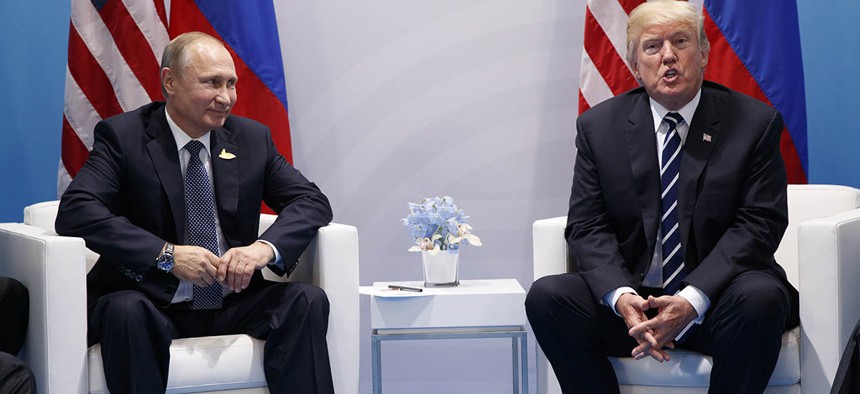How a U.S. and Russian Cybersecurity Partnership Could Work

President Donald Trump speaks during a meeting with Russian President Vladimir Putin at the G20 Summit, Friday, July 7, 2017. Evan Vucci/AP
Odd partnerships aren't unheard of the in the cybersecurity world.
John Breeden II is an award-winning journalist and reviewer with over 20 years of experience covering technology and government. He is currently the CEO of the Tech Writers Bureau, a group that creates technological thought leadership content for organizations of all sizes. Twitter: @LabGuys
President Donald Trump made waves at the G20 Summit recently when he suggested the U.S. work with Russia to create a cybersecurity unit to guard against future election hacking. Obviously, this was met with extreme skepticism back home, given there are several ongoing investigations looking into the possibility Russia either hacked into voting systems—or attempted to—in an effort to skew the results of the recent presidential election.
It’s understandable why people would be wary of such a partnership. In the real world, if you suspect a neighbor of breaking into your home and stealing stuff, you probably don’t want to go over and swap keys with them so they can watch your place during your vacation. But in cybersecurity, odd partnerships like that can happen, even if the parties sharing information don’t trust one another, or are in direct competition. Using that model, there is no reason not to try and form a collaboration between the U.S. and Russia on cybersecurity.
» Get the best federal technology news and ideas delivered right to your inbox. Sign up here.
Many private companies accomplish this by relying on a protocol and a language some industries have been using for years, STIX and TAXII, combined with any threat collection program that strips out all proprietary information from collected reports. STIX, the Structured Threat Information eXpression language, helps to standardize threat data in such a way even automated systems can understand it. While TAXII, the Trusted Automated eXchange of Indicator Information, defines protocols to properly transmit that data across organizational boundaries and networks.
A shared cybersecurity program between Russia and the U.S. would be extremely simple to configure. Information about threats, specific to election systems if that is what they wanted to concentrate on, would be gathered up and placed into STIX format, or possibly even automatically collected. Each report could contain information about threats to election systems.
For example, one report could include the IP addresses, known aliases and the text of a new phishing scam levied against election officials. It would be packaged up using TAXII and sent into whatever shared program the two nations wanted to use. The final component would be a threat intelligence program, that could collect data and turn it into actionable intelligence, such as blocking the IP addresses of election attackers.
There are many TIPs to choose from. One of my very first columns for Nextgov talked about a free threat intelligence tool called Soltra Edge used by industry and educational organizations. The Homeland Security Department uses another to share threat data with industry partners. The best TIPs can strip out all proprietary information from the submitted feed, so a potential attacker listening in won’t get any information about, say, specific cybersecurity defenses being used by the state of Alabama. That way, Russia could contribute to and improve the shared program but would get no benefit if it also happened to secretly be the attacker.
I have seen programs like this work in private industry, even among bitter rivals. So long as the threat intelligence being generated can potentially benefit every participant, with no negative consequences, and no proprietary data being shared, the programs work well and help to improve overall security for everyone involved.
In such a system, there would be a lot of incentive for Russia to participate. If the Russians can help uncover threats against U.S. election systems, it would go a long way to proving they can be trusted. Russia could also benefit by acting on U.S. reports about cyberthreats leveled against it, another reason to put a good faith effort into the program.
Setting up a TIP with a shared feed between the U.S. and Russia would be a simple task. After that, the success of the program would come down to how much effort both nations wanted to put into it. Implementing the system would not create any new vulnerabilities, and could even be automated to reduce manpower requirements. In any case, the worst thing that could happen, from a U.S. perspective, is Russia won’t contribute anything meaningful to the system once in place. But that, too, might be telling.
NEXT STORY: Agencies Can Tap Tech to Bridge Language Divides



